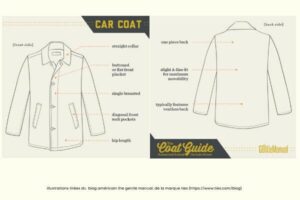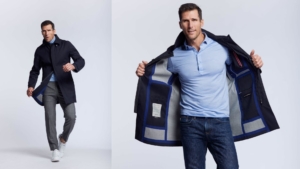As outdoor enthusiasts, we absolutely wanted to have a technical piece in our range that would protect us from the rain, wind and even the cold. But we also wanted a piece with style and character.
It was while digging into the archives that we found the piece that immediately excited us: the car coat. It has evolved over the century in line with technological progress and social mores.
What is its history? How did we revisit it in our turn? This is what we tell you here...
Born with the automobile in 1900
The car coat is first and foremost a functional room.
While cars have no roof or heating, drivers and passengers need to be protected. They also need to be able to move easily to repair these machines that often break down...
Unsurprisingly, the first version of the car coat is long, loose and warm. Made of leather, heavy tweed or fur (or lined with fur), it has buttons up to the neck. It is unisex because the priority is function.
There is a summer version, made of linen or wool (duster) to protect against dust only.
the car coat is a statutory piece
The car coat is rapidly becoming a coveted social attribute. It signifies that you are the proud owner of a vehicle. Drivers play with it and wear it in everyday life to assert their status.
This is the beginning of the car coat's second life!
it changes over time
The car coat initially followed the evolution of mechanical comfort. The bonnet and the heating require a shorter and lighter garment.
But it also adapts to the materials. In the 1920s it was made of tweed, wool velvet and Cheviot (sheep's wool with a diameter of 30 microns). Then in the 1930s, suede and silk were even used.
In terms of construction, two major advances should be noted. The appearance of the zip which will make it more practical. But also the raglan sleeve (seamless sleeve assembly at the shoulder) which will improve freedom of movement.
the car coat then becomes the Jeep coat
As with its cousin, the trench coat, the army will take over its transformation.
And it was during the Second World War, when American troops landed at the wheel of open-topped jeeps, that a new version of the car coat became popular.
It is a little longer than a jacket (so as not to interfere with driving comfort), has two pockets that rest on the knees when driving, and benefits from a high collar and waist belt.
and then modernises again
The post-war period brought the revolution of synthetic materials. In the 1960s, nylon was used for its lightness and protective qualities. But brushed fleece, quilted lining or water-repellent treatments with washable suede were also used.
Even if some tricks remain (covered buttons so as not to get caught in the seatbelt), in terms of style, the car coat has freed itself from its initial function as a driving accessory.
It asserts its current style: mid-thigh length, two vertical pockets, straight collar.
we make it part of the movement!
We have obviously kept the DNA of the car coat: mid-thigh length, alcantara stand-up collar, raglan sleeves, covered buttons, diagonal zipped outside pockets.
But also its performance level! A three-layer technical fabric from Marzottoin wool and viscose with a windproof membrane makes it waterproof up to 10 metres. It is fully thermo-glued to increase its durability and lightness. All zips are waterproof.
We have added zips under the armpits to prevent the sweating. And reflective strips under the cuffs and in the collar.
The history of this iconic piece is therefore not trivial. Born of a necessary function (to protect, to warm) it has evolved with technological progress to constantly re-invent itself. Without losing its soul.
At a time when style and function are back in the forefront of our concerns and lifestyles, we are proud of our car coat. It's highly versatile and will go everywhere with efficiency and character.
It is no coincidence that we have called our car coat Boundless...






